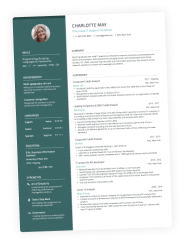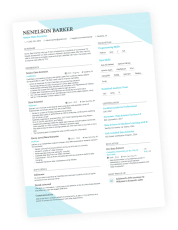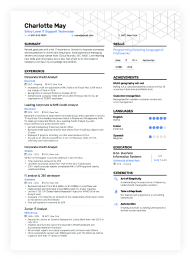Back in school, you were probably taught to write your full address on your CV. Your teachers even showed you exactly where to put it. At the time, it was considered an essential part of any work application. But with remote work and concerns around data and privacy, hiring practices have changed.
So, should you include your address on your CV? In most cases, the answer is no. That said, there are situations where it might still make sense.
In this guide, we cover when to leave it out, when to add it, and how to format it correctly if you do.
Here's what to know before you decide.

Key takeaways
- Most of the time, skip your full address: UK employers rarely need it, and it can actually work against you in many cases.
- General location is enough: City or postcode area shows you’re in the right place without giving away too much.
- Follow the job ad: If it asks for your full address, include it. It’s as simple as that.
- Regulated or public sector roles are different: These often require full details upfront, especially for compliance or checks.
- Don’t make it hard to find: If you do write your full address out, keep it in your header—never in the footer.
- Keep things tidy: Whether you use a full or partial address, make sure it’s clear, short, and fits neatly with the rest of your contact info.
Understanding if and how to put your address on your CV doesn’t have to be hard. Read our tips below to help you make the decision.
Is your CV good enough?
Drop your CV here or choose a file. PDF & DOCX only. Max 2MB file size.
Should you put your address on your CV in the UK?
First, let’s deal with the central question. Most of the time, you don’t need to put your address on your CV. However, there are exceptions to keep in mind.
Let’s break down what you need to know:
There’s no legal requirement
Ignore any rumours you might have heard—there’s no law that says you have to add your address to your CV in the UK. In fact, you might end up landing yourself in hot water if you do so.

Data protection and your address
Data protection laws (under the UK General Data Protection Regulation (UK GDPR) and the Data Protection Act 2018) are there to keep you and your private information safe.
Once you’ve submitted a CV to an employer, they become a “data controller”. That means that they're legally responsible for handling your data properly.
It’s your legal right to “be informed about how your data is being used”. If you’re at all worried about this, it’s worth reaching out to the employer and asking.
Add your location instead
While including your complete address on your CV is often unnecessary, you may want to add your location—city and country is enough. If you’re applying for on-site or hybrid work, this is particularly important.
The hiring manager will want to know that you're within a reasonable distance to commute to the office. Of course, if you’re willing to relocate for the right job, you should also mention that on your CV.
Why employers want to see your location:
- To confirm you’re eligible to work in the country or region (especially important for visa or right-to-work checks).
- To assess how your location aligns with the company’s office, commute expectations, or hybrid work policy.
Here’s how your location can look on a CV header:
- Manchester, UK
- Birmingham, UK (Open to relocation)
- London, UK – Right to work in the UK
It was once quite common to list your full address on your CV, but this idea is more or less a thing of the past these days. Broadly speaking, there's no need to state more than your region when applying for a job as employers usually only need to know your general location.
Of course, there are times when you’ll want to include your address on your CV. Later in this guide, we’ll be covering the times when you should do this.
For now, let’s focus on when it’s better left off.
When to remove your address from your CV?
Modern hiring practices are shifting away from location-based filtering.
Here‘s when NOT to list your full address on your CV:
The job advert didn’t ask for it
First things first, check whether the job advert specifically asks for your full address. If it doesn’t, leave it out. Most employers are only interested in knowing whether you’re in the right area, not your street name or door number.
It’s no longer standard to include your full address on a CV, especially when applying online. Stick to your general location (like city or even your postcode area) unless the role clearly requires more detail.

Always read the core criteria
Before you apply, take the time to read the job description and any listed criteria carefully. Some roles come with specific instructions, like whether to include your address or leave it out.
Overlooking these details could hurt your chances of landing an interview, even if you’re a strong fit for the role. Following the application guidelines shows you're paying attention, and that matters.
You have privacy concerns
Your privacy should be your number one priority at all times. When you share your full address, you’re giving away more than you might realise, especially if you're applying to a large company, a recruitment agency, or through a public jobs board.
Chances are, your CV will pass through multiple systems or individuals before reaching a decision-maker. Unless the job specifically requires your full address for background checks or relocation planning, it’s smarter to leave it off and avoid unnecessarily sharing it.
Privacy is the main concern people have with listing their full address. After all, you never know who's going to review your resume, so keeping personal details to yourself is probably wise.
You want to avoid judgment
Your home address tells the recruiter a whole lot about you, including your socio-economic status. While it’s unfair for them to judge you based on where you live, people often have unconscious biases.
To keep the focus on your experience, skills, and suitability for the role, you can simply add your general location. That way, the hiring manager will only judge you on attributes that are relevant to the role.
Listing your full address can also put you at a disadvantage. Potential employers might develop a bias against your application because of your distance to the office or the neighborhood you live in. That's not fair but it's something people should keep in mind.
You’re applying for a remote role
The beauty of remote work is that you can do it from anywhere in the world. Remote employers may care about your location and—in particular—your timezone. However, as long as you’re able to work when they need you to, where you happen to live shouldn’t matter to the hiring manager.
When you’re applying for a remote role, you should leave your address off your CV. Not only is this the best practice, but it shows that you’re aware of the hiring standards that apply to these positions.
When to include your address on your CV
You know the drill: there are exceptions to every rule. While most of the time you shouldn’t state your address on your CV, there are times when you’ll need to. For example, certain roles, industries, or application processes may still expect to see it.
Check out the main times you should add it to your CV:
The job advert specifies you need it
Some employers will specify that you need to include your address on your CV. If you see this in the job description, make a note of it and tailor your CV accordingly. Showing that you can follow simple instructions is a quick way to prove that you’re a conscientious and smart worker.

Why does the recruiter need my address?
Sometimes it's about verifying you're within a commutable distance, or meeting internal HR or compliance policies. In some cases, your address details may be needed for early-stage background checks or to confirm right-to-work status.
You’re applying to the public sector
Applications to the public sector tend to be more detailed than those in the private sector. For example, they may require additional personal information (like your full address), structured forms, and even formal documentation as part of the initial screening process.
When you’re applying for this type of role, get up to speed on the correct process. You can find more guidance on how to apply for these roles on the government and public sector websites.
Let’s take a look at the type of specifications a public sector role may include:
Public sector role location requirements
- UK nationals
- Nationals of the Republic of Ireland
- Nationals of Commonwealth countries who have the right to work in the UK
- Candidates living within a commutable distance to the site, or willing to relocate
Keep in mind that each role is different and may have different requirements. Make sure you’re clear on the criteria of a vacancy before you begin applying.
There are some situations where I would say it is a smart move to add an address. One example would be a regulated role, or a position with a government agency, where full identification details are required early in the process for compliance or security clearance reasons.
The employer needs it for background checks
Some jobs need extra checks—like a DBS (formerly CRB), right to work, or ID verification—and your address is part of that process. If the employer asks for it, they’re not being nosy. It just helps them get the paperwork started early. Make their life easier, and you have a better chance of success.
You’ll usually see this with roles in healthcare, education, finance, or anything involving sensitive info or vulnerable people, such as children. If the job advert mentions background checks, it’s a good idea to include your full address, just to keep things smooth and straightforward.
You’re applying in a regulated industry
Applying for a job in a regulated industry? Don’t be surprised if the employer asks for your full address. For example, if you work in healthcare, the employer may need this detail to prove your registration with professional bodies (like the GMC, NMC, or HCPC).
Other regulated industries where address details may still be requested or expected include:
- Finance (e.g. banks, insurance, accounting firms, which are regulated by the FCA)
- Law (especially roles tied to the courts or legal aid)
- Education (especially state schools and local authority positions)
- Security or defence (MOD contractors and SIA roles)
Where to put your address on your CV
If you do need to include your address, putting it in the right place is essential. When it comes to where to put your address, the answer is within your CV header.
This sits neatly at the top of the page and contains your contact information. The reason this works so well is that it’s one of the first things that a hiring manager will read. You don’t want to make the mistake of burying your address (or other vital information!) at the bottom of the page.

Make the hiring manager’s job easy
If your address is hard to spot and the hiring manager needs it, they might pass over your application. Place it front and centre to make sure that this is not an issue.
Your CV header includes the main contact details a hiring manager needs. Getting this right shows that you’re on the ball and understand the hiring manager’s expectations.
Here’s a quick rundown of the format:
- Name: That’s your full name, including your first name and surname.
- Email: A professional email address that has your name in it (e.g., john.smith@email.com)
- Phone number: A number that you use regularly.
- LinkedIn or website: If appropriate, you can add a link to a professional website (e.g. a portfolio) and/or your LinkedIn profile.
- Address: If you are including your address, you should add it at the end.
Here’s an example header created with Enhancv’s AI CV Builder:
How to write an address in a CV (UK format)
You don’t need your full address most of the time. That means no street name, no door number, and not spelling out your full postcode.
Unless it’s one of the situations we’ve talked about, you only need to list your general location. Stick to something simple like your region, city, or county.
Of course, if you’re going with the full version, you need to keep it clean. Just follow the standard UK address format when writing it. No need to overdo it.
Here’s how that looks:
A full address on a CV
- House number: The number of your house, flat, or other property.
- Street name: The name of your street or road.
- City (optional): If you live in a big city, you might add it here.
- County: Your county, e.g. “South Yorkshire”.
- Postcode: Your full postcode, or just the start, e.g. “S1”.
- Country (optional): Applying abroad? You might want to write “United Kingdom”, too.
CV address examples: Full vs. partial
Looking for some inspiration? You’ve come to the right place. Whether you decide to include your full address or just your location, there’s a right way to share this information with an employer.
Look at two clear examples you can adapt for your CV:
Example #1 – partial address
99% of the time, you only need to include a partial address. You can add your region, city, or county here. You may also want to slide in the acronym “UK” for extra clarity.
This approach works as it lets the hiring manager know where you are without giving away too much personal information on your CV. It strikes the right balance. It’s enough detail to show you're in the right area, but not so much that you're oversharing or compromising your data. It also keeps things clean and focused, which is exactly what you want in a contact section.
Example #2 – full address
In the rare instances when you need to share your full address, use a straightforward format. Insert this information right below your email address and use one line, if possible.
Your CV address shouldn’t take up too much space, but it does need to be clear. This example works well as it’s straight to the point, easy to read at a glance, and fits neatly alongside your other contact details without cluttering the top of your CV.

PRO TIP
Need help updating your CV contact section? We’ve got you covered. Try Enhancv’s customisable templates that help you stay professional, ATS-friendly, and up-to-date.
Common mistakes when adding an address on a CV
By now, you’ve got a solid idea of when to include your address on your CV. But what trips people up? Let’s look at the common mistakes to avoid when tackling this issue:
Using an outdated address
If you’re using a master CV and updating it, always check that the address is right. You might have moved since the last time you were applying for jobs. Leaving an old address on your CV is a rookie error. Make a habit of checking this when you’re tailoring your CV to each new role.
Adding a full address for a remote role
Spoiler: Remote employers don’t need to know your exact address. Leaving this detail on your CV could make you look old-fashioned or even suggest that you didn’t realise the position was remote. Either way, it’s bad news for you. Check what the employer needs from you by looking at the job description.
Putting your address in the footer
While some people believe you should put your address in the footer of your CV, that’s a real mistake. We advise against using headers and footers in this document as they can trip up ATS software.
Additionally, you want to position your key information at the top of the page—in the header. When the recruiter reads your application, they will naturally pay more attention to the details at the top.
Should you include your LinkedIn address in your CV?
Wait a minute, what about your LinkedIn address? If you're wondering whether to write this on your CV, the short answer is yes. However, you’ll need to make sure that your profile is complete and up to date.
Adding your LinkedIn URL makes it easy for recruiters to check if your work history is accurate, endorsements, and any recommendations you've picked up.

Inconsistencies are major red flags!
Your CV and LinkedIn profile must be a perfect match. When recruiters review these two things, even the smallest of inconsistencies can stand out like a sore thumb.
Ensure your CV location matches the location listed on your LinkedIn profile. LinkedIn typically only shows your general area, such as “Manchester, UK”.
The address format is important here, too. You don’t need to include the full LinkedIn address on your CV. A hyperlink will do the job. Add a shortened URL in this structure: linkedin.com/in/yourname.
Final tips: When to include or skip your address
If you’re still unsure whether to include or skip your address on your CV, here’s a final reminder.
Check out our table to help you make this decision:
Should you add your address to your CV?
| Include your full address if: | Skip your address if: |
|---|---|
|
|
Conclusion
To sum up, there's no hard rule here, but for most UK CVs, leaving out your full address is the smarter move. It’s what modern-day recruiters expect and means you won’t run into any privacy or bias problems. In that case, just include what’s relevant, i.e. enough to show you’re in the right place without oversharing. Keep your contact details tidy, clear, and focused on helping your application.



